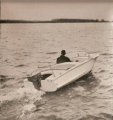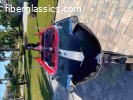Here's an article I saved from the old literature area. If you have a Red Fish boat, it's intriguing.
A Redfish Story
By Lee Wangstad
January 28, 2002
It was an interview that I’ll never forget. It was my first interview with Robert Hammond, founder and former president of Glastron. I was researching my first article for Boating World back in 1993 and was just beginning to understand what the industry was all about during the “recreational revolution” of the fifties. To say that I was nervous would hardly do the word justice. Bob had filled me in on the early days of his career and the parallel story charting the growth of Glastron into the powerhouse of the industry.
I had worked my way through the interview, trying hard not to show just how stressed I was (I think he knew!), when I chanced to ask Bob just what was the relationship between Glastron and the Redfish Boat Company. I mean, there was more than just a passing resemblance. No sooner had the question come out of my mouth when I realized that there was a strange silence coming from the other end of the line. Mr. Hammond had been very quick with his responses through the whole interview. This was an eerie, awkward silence. I broke in, alluding to the similarity of the two boats in hopes of bringing this one back. Still more silence. Finally, Bob spoke; “you know, that is one of the things that still burns me about this business. The Walters brothers took one of our boats, puttied it up and pulled a mold off of it. Added a little bit here and took a little off there and went into production just like that! Planned obsolescence had very little to do with the changing of our styling from year to year....we were trying to keep ahead of the copies that were coming from everywhere!” I decided then and there never to visit Redfish with Bob again.
But he had given me an important clue: the Walters brothers. When Bob Hammond mentioned the name, it became lodged in my memory file, way in the back, where it would remain for a long, long time. I had a couple of pieces of Redfish literature in my collection from 1958 and 1959. The company was located in Clarksville, Texas. There was even a somewhat crude pencil drawing of the Redfish plant on the back of the 1958 brochure. Also in my Redfish file was a single page flyer of the 1963 Regal 17 by the Redfish Boat Company/Iola Molded Plastics, Inc. of Iola, Kansas. This was an interesting link, one that would tie it all together for me later.
One thing that was really surprising was the number of Redfish boats that were turning up. For a company that was busy splashing molds off of other people’s boats, there were a lot of these particular boats coming to the market some 40 years later.
As the years passed and I delved deeper into the marine industry, my Redfish story was still very incomplete. As more of these boats came out of the woodwork, I turned up the heat on my Redfish research. I had seen Doug Young’s Redfish Cruiser on Fiberglassics and knew that I had seen that boat somewhere before. Remembering the 1963 Redfish Regal 17 literature, I went to my IMP (Iola Molded Plastics) file. I had catalogs for most every year from 1963 to 1984. Sure enough, his boat was pictured in the 1963 catalog. Some of the boats in that first catalog had Redfish nameplates while others looked as if someone had airbrushed the IMP name over them. I had never looked that close at the photos before.
I did the usual small town research and found the company still in business. And they were still building boats. Their product line now consists of mostly big offshore high-performance boats. I talked to Jim Huddleston, production manager who told me that, yes they had built Redfish boats at the plant. In fact, there was one Redfish boat that a couple of local people were in the process of restoring for an annual parade coming up. He also told me to contact John Franklin, who could fill me in on the early years of Iola Molded Plastics.
John Franklin was one of the original founders of Iola Molded Plastics. He told me that Redfish had been originally founded in 1957 by H.A. Walters, president, and his brother Herman Walters, vice-president, in Clarksville, Texas.
John Franklin had finally brought a little more presence to the Walters brothers. Real names to go with the story. The Walters’ began their boating enterprise by building and selling molded and paneled plywood boats. In late 1957 John Dial moved to Clarksville and became the general manager of Redfish boats and was in charge of all production. He brought with him the expertise in fiberglass production that it would take to get this fledgling boat works modernized with this new plastic material.
Their first fiberglass boats were the 15’ 9” (gunwale length) Shark and 15’9” Capri. The Capri would be easy to spot by the three rather large false air intakes on its front deck. The Shark, with its more conventional deck treatment, was closer in appearance to its Glastron counterparts. There was also the Angler, a 14’1” fishing utility.
Shortly after Glastron introduced their 17’ hull in early 1958, amazingly enough, Redfish came out with a new 17’ hull of their own. The similarities between these two boats can be explained by Bob Hammond’s long silence during our phone conversation a few years earlier. This new boat was called the Sea Shark and was available with an optional hardtop, that when ordered, made the Sea Shark even more closely resemble the 1958 Glastron Seaflite than it already did. But the Redfish boats were selling everywhere they were offered. They featured a balsa core hull that was extremely rigid for 1958 production. In late 1958 Redfish discontinued wood boat production in favor of the better selling fiberglass boats.
In 1959 Iola Molded Plastics signed an agreement to produce Redfish boats for the market located to the north of their location in Kansas. The Clarksville plant supplied all molds, jigs, and hardware, and Iola Molded Plastics paid a royalty on each boat sold. The primary market for Iola Molded Plastics was initially Kansas, Missouri and the Oklahoma areas, later spreading to cover all of the Upper Midwest as their dealer network expanded. The IMP Redfish boats had serial numbers beginning with KS and the Clarksville boats serial numbers began with TX.
The first Redfish boat “developed” at the Iola plant was the Oceanic, an “18” footer introduced in late 1959. This boat featured a 17’6” lapstrake design that owed more than a little to a similar Cruisers, Inc. hull from the year before. It was available in either single seat or triple seat utility models. These triple seat utilities had a single seat in the front cockpit facing forward with two parallel seats going down each side of the boat in the rear, facing each other. By 1961 this hull was also used on the Oceanic 18 Cruiser, a flying bridge cruiser with a streamlined deck and cabin.
I was interviewing Bud Hall of McCulloch Corporation back in 1994 while doing the research on the Flying Scott boats of the early 60’s, and I asked him if McCulloch were actually building the boats themselves. He said that “some outfit out of Clarksville, Texas was actually building them.” When I mentioned Redfish, he exclaimed, “that’s it! That’s the one!” Bud had no other recollection about the boats or the Redfish connection other than the little that he had already told me. It was another piece of the puzzle though, and while it didn’t really fit anywhere, it was important in the history of Redfish.
This is where John Franklin really helped out. As it turns out, in 1960 McCulloch contracted with the Redfish Boat Company to develop a line of boats designed by David Beach, Naval Architect. These boats were designed specifically to be sold with the Scott line of engines and came complete with every optional boating accessory imaginable. They even had custom trailers. There were 12 models utilizing 14’ and 17’ hulls. The 17’ boats were produced in the Clarksville plant and the 14’ boats were built at the Iola facility. All of the molds were built in the Clarksville plant, with John Dial overseeing their production.
Building these 17’ boats for McCulloch overtook Redfish production in Clarksville and lasted through late 1962 when Scott pulled their boats from the market. The remaining boats were sold through the 1963 model year. With the Clarksville plant concentrating on its Scott orders, their own Redfish dealers in the south were being neglected. These dealers found little solace in the fact that Redfish was just too busy building Scott boats to fill their Redfish orders. They would leave Redfish behind and sign on with other boat manufacturers who could satisfy their needs.
What McCulloch hadn’t counted on was the resistance from their dealers to take on another boat line. Most of them already had a line covering the high end, and didn’t need another line to compete with what they already had. Other boat manufacturers also resented McCulloch’s intrusion on their market. It was a lose/lose situation.
Meanwhile, H.A. and Herman Walters were living the high life in Clarksville. With private airplanes and luxury automobiles announcing their arrival wherever they went, it didn’t take long before it all caught up with them, which it did resoundingly in 1962. With the Scott orders suddenly gone, and at the same time much of their dealer network with it, they were out of business. John Dial found local financing and bought up what was left and founded Kingfisher Boats in late 1962. Later Kingfisher catalogs would show the Clarksville plant, and if you looked closely, you could see that things hadn’t really changed much since 1958, other than sound financial planning.
Iola Molded Plastics were in much better financial shape than the Walters had been. They found themselves now owning the molds, they still had their northern and Midwest dealers in line, and immediately set up to produce their own line of boats. They had been slowly expanding their lapstrake boat line on their own while the Clarksville plant was busy with the Scott orders. On the last page of the 1963 IMP catalogs was the final epitaph: Formerly Red Fish Boat Company of Kansas, Inc.
As we see another of our fiberglass boat producers of the 50’s drop from the market, miraculously two more successful boat manufacturers rise from the dust. Kingfisher would build boats up until the early 90’s when John Dial decided that enough was enough and got out of the business. Iola Molded Plastics thrived and continues to build boats to this day. The continuing story of these two companies will come later as time allows.
I would like to sincerely thank Jim Huddleston, Mrs. John Dial, and mostly John Franklin for helping me with this history. I also have to thank Bob Hammond for initially planting the seed about the Walters brothers with his resounding silence, and I can’t forget to thank the late Bob Speltz for being who he was and encouraging me all that he did.















